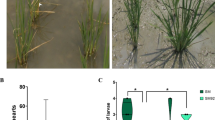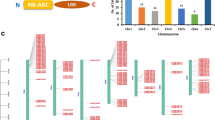Abstract
Mildew resistance locus o (Mlo) is a specific seven-transmembrane gene family that confers resistance against several abiotic and biotic stresses in plants. In this study, we identified nine Mlo-like loci,VfMlo-like3243 (Vitis flexuosa powdery-mildew resistance locus o-like3243), VfMlo-like4098, VfMlo-like5057, VfMlo-like6833, VfMlo-like7881, VfMlo-like8120, VfMlo-like14439, VfMlo-like14557, and VfMlo-like18484, which showed differential expression upon transcriptome analysis conducted using next generation sequencing (NGS) of V. flexuosa infected with Elsinoe ampelina. These genes are 1773–2548 bp long and encode deduced full-length proteins of 482–587 amino acids. The predicted amino acid sequences of all genes show typical Mlo domains containing seven highly conserved transmembrane domains, a calmodulin-binding domain and 30 important amino acid residues for Mlo function. While 3 VfMlo-like genes were downregulated, 5 VfMlo-like genes were up-regulated in grapevines infected with Erysiphe necator, among which four (VfMlo-like6833, VfMlo-like8120, VfMlo-like14439 and VfMlo-like18484) are orthologous to the AtMlo2, AtMlo6 and AtMlo12 genes involved in powdery mildew susceptibility. All genes except VfMlo-like17881 showed upregulated expression at 48 hpi after infection of Rhizobium vitis. The results revealed that the tested genes are related in responses to pathogens of grapevines and can be utilized as useful resources for investigating their roles in disease resistant responses in grapevines.






Similar content being viewed by others
Abbreviations
- NBS-LRR:
-
Nucleotide binding site-leucine rich repeat
- R-gene:
-
Resistance gene
- VfMlo:
-
Vitis flexuosa powdery-mildew resistance locus o
References
Ahn SY, Kim SA, Jo SH, Yun HK (2014) De novo transcriptome assembly of Vitis flexuosa grapevines inoculated with Elsinoe ampelina. Plant Genet Resour C 12:S130–S133
Appiano M, Catalano D, Martínez MS, Lotti C, Zheng Z, Visser RGF, Ricciardi L, Bai Y, Pavan S (2015a) Monocot and dicot Mlo powdery mildew susceptibility factors are functionally conserved in spite of the evolution of class-specific molecular features. BMC Plant Biol 15:257
Appiano M, Pavan S, Catalano D, Zheng Z, Bracuto V, Lotti C, Visser RGF, Ricciardi L, Bai Y (2015b) Identification of candidate MLO powdery mildew susceptibility genes in cultivated Solanaceae and functional characterization of tobacco NtMLO1. Transgenic Res 24:847–858
Bai Y, Huang CC, Van der Hulst R, Meijer-Dekens F, Bonnema G, Lindhout P (2003) QTLs for tomato powdery mildew resistance (Oidium lycopersici) in Lycopersicon parviflorum G1.1601 co-localize with two qualitative powdery mildew resistance genes. Mol Plant Microbe Interact 16:169–176
Bai Y, Pavan S, Zheng Z et al (2008) Naturallyoccurring broad-spectrum powdery mildew resistance in central American tomato accession is caused by loss of Mlo function. Mol Plant Microbe Interact 21:30–39
Bernsel A, Viklund H, Hennerdal A, Elofsson A (2009) TOPCONS: consensus prediction of membrane protein topology. Nucleic Acids Res 37:W465–W468
Bhat RA, Miklis M, Schmelzer E, Schulze-Lefert P, Panstruga R (2005) Recruitment and interaction dynamics of plant penetration resistance components in a plasma membrane microdomain. Proc Natl Acad Sci USA 102:3135–3140
Buschges R, Hollricher K, Panstruga R et al (1997) The barley Mlo gene: a novel control element of plant pathogen resistance. Cell 88:695–705
Chang S, Puryear J, Cairney J (1993) A simple and efficient method for isolating RNA from pine trees. Plant Mol Biol 11:113–116
Chen Z, Hartmann HA, Wu M et al (2006) Expression analysis of the AtMLO gene family encoding plant-specific seven-transmembrane domain proteins. Plant Mol Biol 60:583–597
Chen Y, Wang Y, Zhang H (2014) Genome-wide analysis of the mildew resistance locus o (MLO) gene family in tomato (Solanum lycopersicum L.). Plant Omics 7:87–93
Consonni C, Humphry ME, Hartmann HA et al (2006) Conserved requirement for a plant host cell protein in powdery mildew pathogenesis. Nat Genet 38:716–720
Crooks GE, Hon G, Chandonia JM, Brenner SE (2004) WebLogo: a sequence logo generator. Genome Res 14:1188–1190
Dangl JL, Jones JD (2001) Plant pathogens and integrated defence responses to infection. Nature 411:826–833
Deshmukh R, Singh VK, Singh BD (2014) Comparative phylogenetic analysis of genome-wide Mlo gene family members from Glycine max and Arabidopsis thaliana. Mol Genet Genomics 289:345–359
Deveto A, Piffanelli P, Nilsson I et al (1999) Topology, subcellular localization and sequence diversity of the Mlo family in plants. J Biol Chem 274:34993–35004
Devoto A, Hartmann HA, Piffanelli P et al (2003) Molecular phylogeny and evolution of the plant-specific seven-transmembrane MLO family. J Mol Evol 56:77–88
Eastwell KC, Sholberg PL, Sayler RJ (2006) Characterizing potential bacterial biocontrol agents for suppression of Rhizobium vitis, causal agent of crown gall disease in grapevines. Crop Prot 25:1191–1200
Eibach R, Diehl H, Alleweldt G (1989) Untersuchungen zur vererbung von resistenzeigenschaften bei reben gegen Oidium tuckeri, Plasmopara viticola and Botrytis cinerea. Vitis 28:209–228
Elliot C, Muller J, Miklis M, Bhat RA, Schulze-Lefert P, Panstruga R (2005) Conserved extracellular cysteine residues and cytoplasmic loop-loop interplay are required for functionality of the heptahelical MLO protein. Biochem J 385:243–254
Elliott C, Zhou F, Spielmeyer W, Panstruga R, Schulze-Lefert P (2002) Functional conservation of wheat and rice Mlo orthologs in defense modulation to the powdery mildew fungus. Mol Plant Microbe Interact 15:1069–1077
Feechan A, Jermakow AM, Torregrosa L, Panstruga R, Dry IB (2008) Identification of grapevine MLO gene candidates involved in susceptibility to powdery mildew. Funct Plant Biol 35:1255–1266
Feechan A, Jermakow AM, Ivancevic A, Godfrey D, Pak H, Panstruga R, Dry IB (2013) Host cell entry of powdery mildew is correlated with endosomal transport of antagonistically acting VvPEN1 and VvMlo to the papilla. Mol Plant s Interact 26:1138–1150
Felsenstein J (1985) Confidence limits on phylogenesis: an approach using the bootstrap. Evolution 39:783–791
Guruprasad K, Reddy BV, Pandit MW (1990) Correlation between stability of a protein and its dipeptide composition: a novel approach for predicting in vivo stability of a protein from its primary sequence. Protein Eng 4:155–161
Hammond-Kosack KE, Jones JD (1996) Resistance gene-dependent plant defense responses. Plant Cell 8:1773–1791
Hammond-Kosack KE, Jones JDG (1997) Plant disease resistance genes. Annu Rev Plant Physiol Plant Mol Biol 48:575–607
Hammond-Kosack KE, Jones JD (2000) Response to plant pathogen. In: Buchanan BB, Gruissem W, Jones RL (eds) Biochemistry and Molecular biology of plants. American Society of Plant Physiologists, Rockville, pp 1102–1156
Jorgensen JH (1992) Discovery, characterization and exploitation of Mlo powdery mildew resistance in barley. Euphytica 63:141–152
Joshi RK, Nayak S (2011) Functional characterization and signal transduction ability of nucleotide-binding site-leucine-rich repeat resistance genes in plants. Genet Mol Res 10:2637–2652
Kim MC, Lee SH, Kim JK, Chun HJ, Choi MS, Chung WS, Moon BC, Kang CH, Park CY, Yoo JH, Kang YH, Koo SC, Koo YD, Jung JC, Kim ST, Schulze-Lefert P, Lee SY, Cho MJ (2002a) Mlo, a modulator of plant defense and cell death, is a novel calmodulin-binding protein. J Biol Chem 277:19304–19314
Kim MC, Panstruga R, Elliot C, Muller J, Devoto A, Yoon HW, Park HC, Cho MJ, Schulze-Lefert P (2002b) Calmodulin interacts with MLO protein to regulate defence against mildew in barley. Nature 416:447–450
Kong X, Lv W, Jiang S, Zhang D, Cai G, Pan J, Li D (2013) Genome-wide identification and expression analysis of calcium-dependent protein kinase in maize. BMC Genomics. doi:10.1186/1471-2164-14-433
Konishi S, Sasakuma T, Sasanuma T (2010) Identification of novel Mlo family members in wheat and their genetic characterization. Genes Genet Syst 85:167–175
Kono A, Nakaune R, Yamada M, Nakano M, Mitani N, Ueno T (2009) Effect of culture conditions on conidia formation by Elsinoe ampelina, the causal organism of grapevine anthracnose. Plant Dis 93:481–484
Kortekamp A, Welter L, Vogt S, Knoll A, Schwander F, Töpfer R, Zyprian E (2008) Identification, isolation and characterization of a CC-NBS-LRR candidate disease resistance gene family in grapevine. Mol Breed 22:421–432
Letunic I, Doerks T, Bork P (2009) SMART 6: Recent updates and new developments. Nucleic Acids Res 3:D229–D232
Liu Q, Zhu H (2008) Molecular evolution of the Mlo gene family in Oryza sativa and their functional divergence. Gene 409:1–10
Mirica II (1994) Ripe rot. In: Pearson RC, Gohen AC (eds) Compendium of grape diseases. American Phytopathological Society, St. Paul, pp 18–19
Osakabe Y, Maruyama K, Seki M, Satou M, Shinozaki K, Yamaguchi-Shinozaki K (2005) Leucine-rich repeat receptor-like kinase1 is a key membrane-bound regulator of abscisic acid early signaling in Arabidopsis. Plant Cell 17:1105–1119
Panstruga R (2005) Discovery of novel conserved peptide domains by ortholog comparison within plant multi-protein families. Plant Mol Biol 59:485–500
Pavan S, Jacobsen E, Visser RGF, Bai Y (2010) Loss of susceptibility as a novel breeding strategy for durable and broad-spectrum resistance. Mol Breed 25:1–12
Pessina S, Pavan S, Catalano D, Gallotta A, Visser RGF, Bai Y, Malnoy M, Schouten HJ (2014) Characterization of Mlo gene family in Rosaceae and gene expression analysis in Malus domestica. BMC Genom 15:618
Piffanelli P, Zhou F, Casais C, Orme J, Schaffrath U, Collins N, Panstruga R, Schulze-Lefert P (2002) The barley MLO modulator of defense and cell death is responsive to biotic and abiotic stress stimuli. Plant Physiol 129:1076–1085
Reisch BI, Owens CL, Cousins PS (2012) Grape. In: Badenes ML, Byrne DH (eds) Fruit breeding, Handbook of plant breeding (II). Springer, New York, pp 225–262
Riaz S, Tenscher AC, Ramming DW, Walker MA (2011) Using a limited mapping strategy to identify major QTLs for resistance to grapevine powdery mildew (Erysiphe necator) and their use in marker-assisted breeding. Theor Appl Genet 122:1059–1073
Saitou N, Nei M (1987) The neighbor-joining method: a new method for reconstructing phylogenetic trees. Mol Biol Evol 4:406–425
Staskawicz BJ, Ausubel FM, Baker BJ, Ellis JG, Jones JDG (1995) Molecular genetics of plant disease resistance. Science 268:661–667
Taler D, Galperin M, Benjamin I, Cohen Y, Kenigsbuch D (2004) Plant R genes that encode photorespiratory enzyme confer resistance against disease. Plant Cell 16:172–184
Tamura K, Stecher G, Peterson D, Filipski A, Kumar S (2013) MEGA6: molecular evolutionary genetics analysis version 6.0. Mol Biol Evol 30:2725–2729
Wang Q, Zhang Y, Gao M, Jiao C, Wang X (2011) Identification and expression analysis of a pathogen responsive PR-1 gene from Chinese wild Vitis quinquangularis. Afr J Biotechnol 10:17062–17069
Wolter M, Hollricher K, Salamini F, Schulze-Lefert P (1993) The mlo resistance alleles to powdery mildew infection in barley trigger a developmentally controlled defense mimic phenotype. Mol Genet Genomics 239:122–128
Yun HK, Park KS, Roh JH, Choi YJ, Jeong SB (2007) Developing a screening system for resistance to anthracnose in grapevines using culture filtrates from Elsinoe ampelina. J Hortic Sci Biotechnol 82:360–364
Zheng Z, Appiano M, Pavan S, Bracuto V, Ricciardi L, Visser RGF, Wolters A-MA, Bai Y (2016) Genome-wide study of the tomato SlMLO gene family and its functional characterization in response to the powdery mildew fungus Oidium neolycopersici. Front Plant Sci. doi:10.3389/fpls.2016.00380
Zhou SJ, Jing Z, Shi JL (2013) Genome-wide identification, characterization and expression analysis of the MLO gene family in Cucamis sativus. Genet Mol Res 12:6565–6578
Acknowledgments
This work was supported by a Grant (PJ011631) from the Agricultural R&D Project, Rural Development Administration, Republic of Korea.
Author information
Authors and Affiliations
Corresponding author
Rights and permissions
About this article
Cite this article
Islam, M.Z., Yun, H. Characterization of nine Mlo family genes and analysis of their expression against pathogen infections in Vitis flexuosa . Euphytica 211, 379–394 (2016). https://doi.org/10.1007/s10681-016-1752-9
Received:
Accepted:
Published:
Issue Date:
DOI: https://doi.org/10.1007/s10681-016-1752-9




